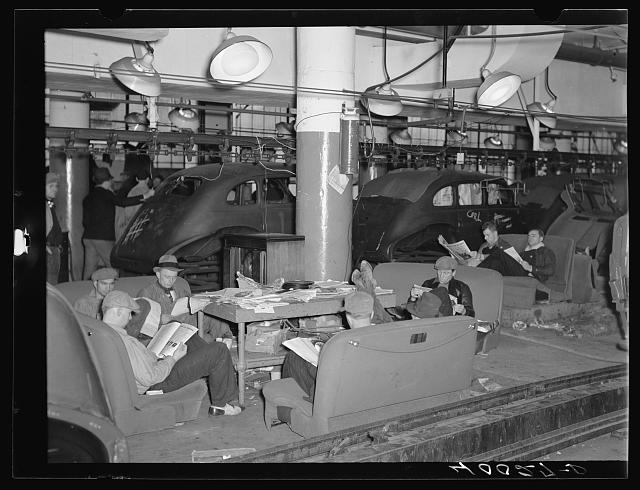Today’s megacorporations are non-union and intend to stay that way. Unions have experimented with how to organize these giants, so far with little success. Eighty years ago, manufacturing unions also faced the challenge of organizing a new and rapidly growing industry. What can we learn from these earlier struggles?
In the 1920s, the labor movement appeared to be dying, and the fledgling manufacturing unions were weak. Many observers were skeptical that manufacturing could be organized. Yet in the 1930s and 1940s, manufacturing workers and their leaders initiated strikes, formed many new unions, and grew others, making manufacturing one of the most highly unionized industries. Manufacturing went from only nine percent organized in 1910 to 44 percent organized in 1950.
Today’s organizing context is very different from that of the 1930s. The megacorporations of today have political, cultural, financial, and labor market dominance that exceeds that of the largest manufacturing employers of the 1930s. The resources of today’s megacorporations are vast and powerful. They hire a staggering number of employees: Amazon directly employs nearly a million US workers and Walmart employs well over a million. To put that in perspective, Ford had under 200,000 workers in 1930 and fewer than 140,000 by 1935, which is slightly less in terms of their percentage of the civilian labor force compared to Walmart’s and Amazon’s employment today.
Workers of today’s megacorporations also confront different employment relationships. Employers often use strategies like subcontracting, independent contractors, temporary workers, and high turnover to offload labor risk. They have deep pockets, reinforced by diversification and financialization. Even Henry Ford, who was among the richest of his era, was worth “only” 1.2 billion (or about $20 billion today), compared to Jeff Bezos’s $205 billion. The largest chains, from the Dollar Store to McDonalds, often consist of thousands of establishments (rather than one or a handful, which was more common in the 1930s). In this context, a strike at one store — or even one hundred stores — can’t stop services or hit the corporate bottom line with the same magnitude as the sit down strikes of the 1930s. Today’s megacorporations also operate in a favorable political context, though the same can be said for the pro-business climate of the 1920s.
Despite these differences, some of the key questions facing organizers of megacorporations aren’t very different from the questions that union leaders were asking nearly a century ago: given that the traditional strategies and tactics aren’t working, how do we build workers’ power and rein in employers? The specific organizing tactics of the 1930s can’t be blindly applied to today’s megacorporations. Still, we might gain insight from some broad strategic lessons from that period.
Lesson 1. Match strategy to structure
The major challenge for manufacturing workers in the early 1900s was to figure out how to get enough leverage to force employers’ hands. Before the New Deal legislation, they had no help from labor laws — for the most part, the government either turned a blind eye or actively intervened on behalf of companies.
Early American Federation of Labor unions had organized with relative success by focusing on workers with “high skills” (e.g. craft ), in time-sensitive industries (e.g. transportation), or in geographically isolated industries (e.g. mining). These workers were powerful because they were hard to replace during strikes. While successful, focusing on highly skilled workers came at a high cost: it excluded workers who did not have access to apprenticeship training and skilled jobs, including most women and workers of color. This approach was not suitable to organizing manufacturing workers, with their mix of skill, race, ethnicity, and gender. This strategy was also a non-starter for many of the socialist, communist, and anarchist organizers who were intent on organizing for societal-wide change.
By the early 1900s, some union leaders were articulating a new strategy: they’d organize wall to wall, or what is called “industrial organization.” If they could involve all workers in a shop, they’d be harder to replace during strikes. In this way, leaders adopted a model of inclusiveness, bringing more workers (regardless of skill, race, or gender) into the union fold. To be clear, their actual records on confronting racism and sexism — within their workplaces as well as in their own unions — were mixed. Still, this more inclusive orientation marked a significant departure from the dominant AFL craft approach and opened up the door to new forms of power.
Workers embraced a new tactic that fit well with the industry structure: the sit-down strike. This was a key innovation because it made workers difficult to replace (and it was scalable). When workers sat down, they occupied their workstations, meaning that replacement workers had to literally fight to commence that work. This gave workers leverage to stop production and created crises that demanded employers’ attention. It also presented a threat of equipment sabotage that worried employers. A wave of sit-down strikes, including those by Rubber Workers in 1936 (Goodyear in Akron) and Auto Workers in 1937 (General Motors in Flint), ushered scores of manufacturing workers into unions. The sit-down strike was outlawed in 1939. Despite being quickly prohibited, this new strike tactic provided a spark for industrial organizing.
The new industrial orientation was met with fierce resistance by powerful AFL leaders. Nevertheless, a small but growing group of unions, including the United Mine Workers, Western Federation of Miners, and Ladies Garment Workers (along with fleeting rival federations like the Industrial Workers of the World and the Trade Union Unity League), began expanding their efforts to organize industrially. In 1935, the supporters of industrial organization formed their own organization, the CIO. The CIO gathered resources and deployed them to strategic industries (by, for example, creating the Steel Workers, Textile, Petroleum, Construction, Packinghouse, and other organizing committees to tackle powerful anti-union industries).
Key to this strategy was the expansion of solidarity. Instead of limiting unions to skilled and white men, manufacturing workers and their organizers advocated for a more inclusive labor movement. They also identified a scalable and effective tactic — the sit-down strike — that provided the initial spark to organizing. And, critically, they gathered their resources to support their vision.
Lesson 2. Build leadership as you go
This is a simple but important lesson: don’t give up. Keep building, even in the most difficult of times. Manufacturing organizers worked for decades trying to create robust unions. In doing so, they built leadership, gained workers’ trust, and developed and refined tactics based on trial and error. They lost many strikes. But they made some headway in building organizations of like-minded unionists and continued to push new ideas, both within and outside the dominant labor paradigms. Even before the 1930s, organizers had been working for decades to organize manufacturing; it didn’t happen overnight.
In the mid 1920s, the labor movement was in crisis — union membership was shrinking, manufacturing remained relatively unorganized, and the path forward was not clear. However, by the late 1920s, industrial-leaning unions had a few decades of experience, and they had amassed a growing number of passionate and talented left-leaning organizers. When the conditions became ripe for labor action, industrial union organizers were ready. The Great Depression ushered in an era of unrest among unemployed workers along with strikes and other forms of organizing that put pressure on lawmakers and opened possibilities for the fledgling industrial approach.
Lesson 3. Direct action and strikes can help create new opportunities
In addition to pressuring employers, strikes also have the potential to change the political weather by pressuring elected officials to resolve the crisis and creating new political experiences for strikers and their supporters. In shaking up the status quo, strikes helped to create new opportunities that workers and their unions were then able to act upon.
Beginning in the early 1930s, millions of workers were directly involved in strikes. Notably, the uptick in strikes occurred before the 1935 passage of the National Labor Relations Act. The years 1933 and 1934 saw well over a million workers on strike. Not all of these strikes were won, like the gigantic 400,000 worker textile strike of 1934. These direct actions also didn’t all resemble traditional workplace strikes. For instance, what started as a longshoreman strike in 1934 escalated into the San Francisco general strike, which mobilized 130,000 workers across multiple industries. Strikers also often organized support from the community. For example, women supporters of the Flint sit-down strike formed the Women’s Auxiliary. They collected funds, organized childcare, and eventually defended the strikers from police by forming human shields (armed with mops and rolling pins) and smashed factory windows to enable strikers to breathe after tear gas was deployed. Unemployed workers also embraced direct action, including confrontations with officials, hunger marches, and eviction protests. Combined, these actions ratcheted up labor unrest to levels that became increasingly difficult to ignore. Strikes and direct actions got political leaders’ attention and “evolved” their stance on labor-friendly laws. They also provided direct political education and experience to workers and community members, sharpening their power and their vision of what was possible.
Figure 1 shows the enormous surge in both union members and strikes in the 1930s. What started as a few hundred thousand striking workers soon spread to millions. Seeing other workers strike (and mostly win) ignited a wave of militancy that would have been hard to imagine only a few years earlier. To put these numbers in perspective, in 1937 over ten percent of the manufacturing workforce was on strike (or over a million out of the 10 million workers employed in manufacturing).
Many of the strikes in the 1930s were about forming unions, in addition to improving conditions. For example, BLS reports show that in 1936, over half of all strikes were over issues of union organization (recognition, closed shops, and union discrimination); 35 percent were about wages and hours, and 13 percent were for miscellaneous reasons.
For the most part, workers were winning. In 1936, about 51 percent of all strikes netted substantial gains for unions, 22 percent were partially won, and 27 percent had little or no gains according to BLS reports. Workers were on the move to form and defend unions, and they were winning strikes more often than not.
Lesson 4: The state sets the playing field
The major and sustained strike wave of the 1930s pushed President Franklin D. Roosevelt to chart a course toward “labor peace” and recovery from the Great Depression. The state’s actions helped provide new opportunities for workers.
The new administration took several steps to usher in a new agenda. Some were symbolic. Through his fireside chats broadcast to radios throughout the country, FDR spoke of the dignity of workers and the benefits of unions. But the state also pursued new laws and agencies. In 1935, the New Deal established workers’ right to collectively bargain and strike and created the National Labor Relations Board to administer union elections and adjudicate unfair labor practice cases.
This deal was not without major problems: it excluded some industries composed predominantly of women and workers of color, it constrained unions in ways that made some union leaders worry, and it was hard to enforce. Still, it marked a new era in labor relations, giving many workers union rights for the first time in US history. Prior to the NLRA, unions were formed by “voluntary” recognition, which often required successful strikes to achieve. With the NLRA, union elections became an additional pathway to unionize. Workers used both tactics — striking and elections — to create viable unions.
Thousands of manufacturing workers took part in these elections. In 1946, the first year the BLS provides data, over 700,000 manufacturing workers, or about five percent of the workforce, had the opportunity to vote in a union election. What’s even more remarkable is how many of these elections unions won. In 1942 (the first year for which we have data), unions won 2,786 of the 3,203 manufacturing elections — an 87% win rate.
To clear the way for the New Deal, the La Follette Committee, active 1936-1941, dramatically uncovered the illegitimate and often unlawful methods firms used to avoid collective bargaining with unions. It exposed the widespread anti-union practices common to employers, including espionage, strike breaking, and hiring private police. The committee also investigated specific megacorporations, including General Motors (GM). As the major GM strikes at Flint exploded, the committee sent witnesses to observe the strike, put company officials on the witness stand, and found that GM had spent $900,000 over three years on industrial espionage.The US government also threatened to curtail some of the power that massive anti-union corporations had amassed, like the mega-supermarket of the time, A&P.
International politics also shaped domestic labor issues. Workers strongly supported US involvement against fascism in World War II, which ushered in new demand for wartime production and made manufacturing workers indispensable. Legions of working-age men were enlisted, creating a tight labor supply, and opening access to jobs for women (if only temporarily) and workers of color. These factors gave manufacturing workers more leverage than they had in earlier years, and many used the opportunity to strike and organize for improved working conditions and pay. Again, the government stepped in, this time in the form of the War Labor Board to mediate disputes to avoid stoppages and to administer wage controls.
Reflections on Today
This history points us toward several key questions for today’s organizing.
What would it mean to match organizing strategy to the structure of today’s megacorporations? Given the weak labor laws of today, the structure of megacorporations doesn’t align well with an individual workplace strategy, like striking or running elections establishment by establishment. Part of the manufacturing union organizing strategy was to expand solidarity, moving from an exclusive model of craft organizing to a more inclusive model that encompassed workers of all skill levels, races, and genders. Workers at megacorporations today don’t have many of the characteristics that succeeded with industrial (or craft) strategies — they have high turnover, layers of franchising and subcontracting, and extremely powerful employers. Having strong workplace solidarity is necessary, but it’s probably not enough to move the needle. But solidarity could be expanded by rooting struggles against megacorporations within communities more broadly.
A related question is how to get the state to step in to regulate overly powerful employers. The 1930s saw major legislation in the New Deal. But it also had the state’s symbolic support through fireside chats, the courts’ threats to break up powerful corporations, on-the-ground support of the investigative La Follette Committee, and new arrangements derived from the War Labor Board. The combination of strikes, a less anti-union administration, and the need to address the Great Depression and, later, the war helped to propel government action. What events of today (climate change, the pandemic, supply chain failures, wars, depressions), political alignments, or actions by workers have the ability to shake up the status quo?
Another major question is the role of strikes and direct action. Labor unrest was a crucial part of the 1930s organizing. These actions were not only among already unionized workers — there were general strikes, unemployed actions, community support groups, and strikes for union recognition and contracts. Strikes helped win material gains, showed other workers the power of collective action, and pushed politicians to “reconsider” their stance on labor issues. Today’s strikes are nowhere near the level of unrest seen in the 1930s. But there are significant groups of workers that have successfully used strikes to build their power, including the Red for Ed strikes in 2018 and 2019 and the “striketober” strikes of 2021. What other groups of workers and community groups might be well-positioned to take action, and how can organizers build toward this potential?
We don’t have all of the answers to these questions. But we do know that while the surge in manufacturing unionism appeared to happen almost overnight, it was built on decades of trial and error, during which time organizers experimented with multiple tactics. There were many failures, but organizers continued to innovate and build. When the conditions were right, workers and leaders were ready to use that experience and take matters into their own hands.
Figure 1. The number of manufacturing union members and manufacturing workers involved in strikes. Data: The Bureau of Labor Statistics (BLS) provides strike data beginning in 1927; union membership is compiled by authors’ research


